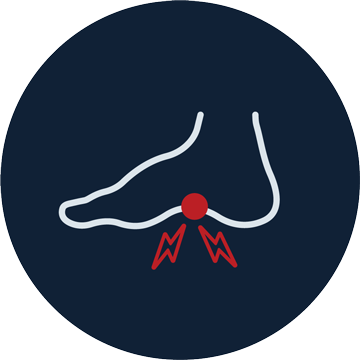
Heel Pain
We Treat
If you are experiencing heel pain, you are not alone. Heel pain is one of the most common types of foot pain, and can be caused by a variety of factors.

What is Heel Pain?
Heel pain is a common foot complaint and may involve injury to different areas of the foot. Heel pain can be attributed to a number of different injuries, conditions and diseases, including overuse, injury, and underlying medical conditions.
Overuse injuries are the most common type of heel pain. These injuries are usually the result of repetitive stress on the heel, such as from running or dancing.
Injury to the heel can also occur from a single traumatic event, such as landing incorrectly after a jump. This type of injury is more likely to be associated with bruising, swelling, and pain in other parts of the foot as well.
There are also a number of medical conditions that can cause heel pain. These include arthritis, diabetes, nerve disorders, and gout. Treatment for heel pain will vary depending on the underlying cause.
Causes of Heel Pain
Common conditions associated with heel pain include:
Plantar Fasciitis
Plantar Fasciitis is a condition that results from inflammation of the plantar fascia, which is the connective tissue that runs along the bottom of your foot from your heel to your toes.
Heel Spurs
A heel spur is a bony growth on the underside of the heel, which is often the result of Plantar Fasciitis.
Severs Disease
Severs is an inflammation of the growth plate in the heel of growing children, typically adolescents. The condition presents as pain in the heel and is caused by repetitive stress to the heel and is thus particularly common in active children. It is largely a chronic overuse injury.
Ankle Sprains
An ankle sprain is an injury to the ligaments that connect the bones of the leg to the foot. The most common type of ankle sprain occurs when the foot is turned inward while the leg is straightened, causing the ligaments on the outside of the ankle to stretch or tear.
Tendinopathies
Tendinopathies are a type of injury that results from the overuse of a tendon, typically resulting in inflammation or degeneration of the tendon.
Achilles Tendonitis
Achilles tendonitis is an inflammation of the Achilles tendon, which is the largest tendon in the body that connects the calf muscle to the heel bone. The condition is common in runners and other athletes who put repetitive stress on their feet and legs.
Bunions
A bunion is a deformity of the big toe in which the toe turns inward, toward the other toes, and a bony growth develops on the side of the foot. Bunions can be painful and make it difficult to wear shoes. They are often caused by genetics, but they can also be the result of arthritis or other conditions that cause the bones in the foot to change.
Stress Fractures
Stress fractures are tiny cracks in the bone that occur as a result of repetitive stress or overuse. They are common in runners and other athletes.
Shin Splints
Shin splints are a type of overuse injury that results in pain in the shin, which is the bone in the front of the leg.
Arthritis of the Ankle
Arthritis is a condition that causes inflammation of the joints. There are many different types of arthritis, but the most common form that affects the ankle or foot is osteoarthritis. This type of arthritis occurs when the cartilage that cushions the joints breaks down, causing pain and stiffness.
Soft Tissue Inflammation
Soft tissue inflammation is a general term used to describe inflammation of the muscles, tendons, and ligaments. The most common type of soft tissue inflammation is tendonitis, which is an inflammation of the tendons.
Bursitis
Bursitis is an inflammation of the bursa, which are small, fluid-filled sacs that act as cushions between the bones and the tissues around them. Bursitis often occurs in the shoulder, elbow, or hip, but it can also affect the ankle. The most common symptoms of bursitis are pain, swelling, stiffness, and redness.
Tarsal Tunnel Syndrome
Tarsal tunnel syndrome is a condition that causes pain, numbness, and tingling in the foot. The condition is caused by compression of the nerves in the tarsal tunnel, which is a narrow passageway in the ankle.
Sciatica
Sciatica is a condition that causes pain in the sciatic nerve, which runs from the lower back down the leg. The most common symptom of sciatica is pain that radiates from the lower back down the leg. Other symptoms include numbness, tingling, and weakness.
Pinched Nerve
A pinched nerve is a condition that occurs when the nerves are compressed or irritated. The symptoms of a pinched nerve include pain, tingling, numbness, and weakness.
Symptoms of Heel Pain
Symptoms of heel pain can vary depending on the underlying condition. However, the most common symptom is a sharp pain in the heel that is worse when you walk or stand on your feet for long periods of time. Other symptoms may include stiffness, swelling, and redness.
Diagnosis of Heel Pain
Depending on the severity of the condition, the symptoms presented and the level of pain, heel pain is typically diagnosed by taking a thorough medical history, completing a hands-on physical assessment including strength tests and exercises and performing further tests such as x-rays when required.
Heel Pain Treatment
There are several options for treating heel pain. The most conservative approach is to rest, ice the area, and take over-the-counter pain medications. If these measures don’t provide relief, you may need to see a podiatrist for professional treatment. In some cases, surgery may be necessary to correct the underlying problem.
Heel pain treatment may also involve wearing supportive footwear, orthotics or Cam Walkers (Moon Boots) or professional strapping of the foot. Manual therapy techniques, shockwave therapy and flexibility exercises may also assist in treatment of some heel pain conditions.
Recovery from heel pain can take several weeks or months. During this time, it’s important to follow your healthcare professional’s instructions and avoid activities that put stress on your heel. With proper treatment and care, most people are able to recover from heel pain and return to their normal activities.
If you have persistent heel pain that is interfering with your daily life, make an appointment with Northern Spinal and let us help you determine the cause of your pain and develop a treatment plan that will get you on the road to recovery.





